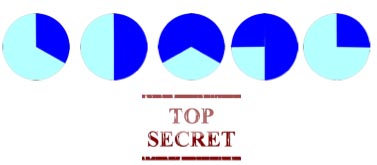Discussion/Introduction
Third graders have a magnetic relationship to secret codes. Anything to do with secret writing, dangerous espionage and top-secret missions brings up the energy in the room several points. Fractions tend not to have that same magnetic appeal. In fact, 1/b notation can look so strange to third graders that the first sight of a page filled with the stuff makes them want to turn their brains off.
If it’s taught wrong, that is to say. Taught right, though, with just the right amount of fun mixed in, third grade fractions can be just as exciting as a top-secret mission in dangerous territory with a good dose of secret codes mixed in.
Download lesson
My free lesson plan, aligned with the Common Core (3.NF.1), is a slightly nontraditional but completely fun look at fractions for third graders. There’s no reason to make fractions dry book learning; let them be a game, a ‘break from the hard stuff’.
Objective
That students would gain familiarity with fractions and learn basic fractional notation: that 1/b is the quantity formed by 1 part when a whole is partitioned into b equal parts and that a/b is the quantity formed by a parts of size 1/b. That they would learn to work as a team, helping the weakest members in order to gain united success.
Supplies
- 1 piece colored folding paper for each student, or construction paper rectangles
- Five flashcards for each student: ½, ¼, ¾, 1/3, 2/3 portions of a circle (printable here)
- One set of large flashcards for teacher, with ½, ¼, ¾, 1/3 2/3 written out.
- ‘Initial Assignment’ missive paper, one copy of each (printable here)
- Secret missive paper, enough for the class; two types (printables here and here)
- Group prizes or ‘winning team’ paper headbands, enough for half the class.
- Math notebooks or writing paper & pencils for each student.
Methodology/Procedure
Tell your students that you’re not going to do much regular math today; today is going to be a fun day. Go on to explain that instead of doing regular arithmetic and adding or dividing (or whatever yesterday’s topic was) you’re going to learn something really cool: a secret code that they’ll be able to use to write important math messages with. And that if they learn it well, they’ll be able to use it right away, in an exciting game that they can play in the classroom.
But tell them that before you start that, you’d like to do a brief review of fractions. Ask them what a half is (one of two equal parts) and how many halves are in a whole (2). Ask what a third is (one of three equal parts) and how many thirds are in a whole (3); then go on to fourths. If they have forgotten any of this or it seems even a little rusty, give them a bit of a refresher. Give them each a rectangle and as you call out ‘half!’ ‘quarter!’ or ‘third!’ have them race to fold it and display the portion you called.
When they’ve got it, tell them they have, and tell them you’re proud of the speed with which they can fold. Tell them now they’ve done their work, so now it’s time to go on to secret codes and the new game.
Ask them what they know about secret codes. Give them a chance to talk about what they know; the final thought you want to come up with—and you can just state it yourself if no-one has similar thoughts—is that a secret code is a way of giving information to one’s friends in a way that one’s enemies can’t understand.
Tell them that another special thing about secret codes is that they’re often short and concise, allowing their writers to put a lot of information in a very little space. Then tell them that now you are going to show them how to write fractions in secret codes.
Draw a circle, and color half. Then, next to it, write ‘half’ on the blackboard. Tell them this is how you write half in plain English. Ask them if it’s easy to read and understand (yes). Ask them if it’s short. (Not too long, but it takes the space of four whole letters).
Ask them how they would make a secret code that would express half.
Encourage them to experiment with different possibilities in their math notebooks. After a few minutes, ask whoever has an idea to come forward and draw it on the blackboard. Provide chalk for each child, and have them write down their secret codes. Ask whoever has a unique notation to explain their secret code and why they chose it to the class.
Then tell them that there are people called mathematicians who decided what the main secret code was going to be for math, and you’ll tell them that secret. Write ½ on the blackboard, next to the word half.
Ask them why they think the mathematicians chose that way. After they’ve had a chance to express their ideas, show them how they can read it as ‘one of two equal parts’, and that the number on the bottom is the number of parts you’ve divided the whole in; the top, the number of those pieces you have.
Ask them to copy ½ down into their math notebook. Then draw another circle on the blackboard, divide in four quarters, color one quarter, and write the word ‘quarter’ next to it. Tell them this is a quarter, and this word is how you write quarter in English. Ask them whether they have any guesses as to how you would write it in math’s secret code.
If you have any volunteers, have them come up to the blackboard try out their ideas, and explain them to the class. Validate each idea, and if anyone writes ¼, tell him that he was thinking in exactly the same way as the mathematicians were. Write ¼ next to your word ‘quarter’.
Go through the same procedure for 1/3rd; here, thought should be united enough that you should be able to call just one confident child up to the blackboard to write down 1/3 as his idea and explain how he got it.
Now draw another circle on the blackboard; divide it into thirds, but instead of shading 1/3 , shade 2/3. Write “two thirds” and ask your students how they’d write it in math secret code.
Ask volunteers to come up and share their ideas with the class. If you get 2 1/3, tell the writer that it is a good idea, but the problem is it looks the same as the way you’d write two wholes and a one third, and draw a picture of that with circles.
When someone comes up with 2/3, tell him he was thinking just like he mathematicians who decided this code.
Pass out the flashcards, and tell the students that when you display your secret code flashcard you want them to pick up and show you the equivalent pie flashcard, without looking at any of their classmates. Go through your cards in random order at least twice; more if some students are having difficulty.
Then tell them it is time for the game. Divide the class in two teams, each with a team leader who has a good grasp of what you’ve been teaching. Tell them that the team that wins will get whatever prize you’ve prepared, or get the honor of wearing ‘winning team’ headbands for the rest of the week in school.
Tell them that when soldiers or intelligence agents use secret codes in war, it is very important that every member of the team is able to do his part well and convey the message without losing any of the meaning. Ask what happens if one of the people passing on a message forgets the secret code (the message is lost). Tell the teams that the same thing will happen if one of their members musses up or forgets the code: they will lose all chance of winning.
Give them five minutes to review the secret code together, and tell the leaders they are responsible for making sure every member of the team understands how to write and decipher the secret code of fractions.
When they are ready, set each team up as a chain. The game will be conducted like telephone; you’ll give the leader of each team a picture with six circles, each divided into different fractions with different parts shaded. They’ll ‘translate this’ on to their missive sheet, writing in math’s secret codes. Then they’ll fold this paper up and pass it to the next team member, who will take it, color and shade the circles on his paper, and pass that paper on to the next team member
Teamplayers will have been given circle and secret missive papers, alternately. You may want to walk up and down the lines checking the work; your responsibility is not to make sure they are doing it correctly, but just that the ‘secret code’ writers are not writing circles and the circle drawers are not writing code.
The first team which sends the message down the line correctly wins. When the message goes down the line, you pick it up and return it to the first player. He compares it with the original paper you gave him. If they are the same, they have won. If they are not correct and the other team has not yet won, he can walk down his line, checking the papers, and find where the mistake began. If he corrects that mistake, the message begins again at that person and is passed on again down the line until it comes to the end.
To avoid bad feelings and loser mentality, you can let the other team continue working till they’ve got the message passed down correctly also, and offer them a consolation prize or ‘silver medal finalists’ headbands.
Tell your students they have learned something incredibly useful today; a secret code with which they can communicate with other math people all over the world.
Don’t forget to encourage them to practice this special code any chance they get. One way of doing this would be by spending some time on our fun fractions activity pages. Visual Fractions is a simple but very enjoyable interactive web application where students can type in any fraction and see it formed before their eyes. The link Online Fraction Games will bring your students to a number of other fraction-based games; some a little above their level, but others that they are ready to tackle.


